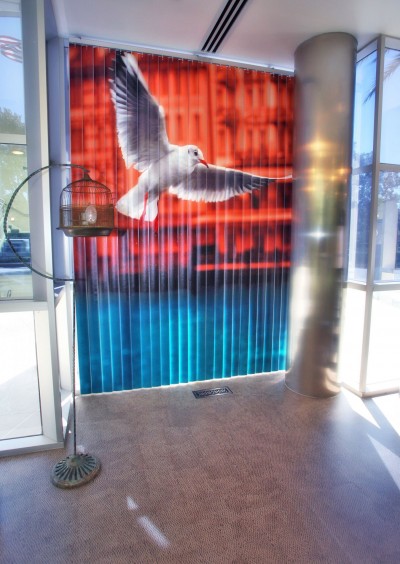Finding the right ink
by Matthew | 10 September 2012 8:30 am
 [1]
[1]File photos
By Tom Sheehan
The demand for wide-format graphics is exploding today—and it is being met by the advanced digital inkjet technology that has emerged in recent years, making wide-format printing possible on a more diverse variety of substrates than before. This market presents a new revenue stream to sign shops and print service providers (PSPs) alike, as digital inkjet printing is among the most effective methods for creating superior-quality image applications that raise brand awareness for advertisers and marketers.
The printing sector has seen dramatic changes in the last decade, from quicker turnaround times to the expanded use of digital technology. While wide-format inkjet presses have been available for some time now, as the technology becomes more reliable and affordable, it has been making more inroads into printing and sign businesses.
Originally, many printing companies used wide-format presses primarily to create only proofs, not final output. Eventually, they realized the equipment could open the door to a broader range of jobs and customers by expanding their abilities to print a variety of applications involving non-paper substrates. This shift generated such impressive new revenues, many small commercial and ‘quick’ PSPs developed their own sign departments or bought existing sign shops as expansion opportunities.
Many large-format print jobs—including point-of-purchase (POP) displays, posters and window graphics—are being produced today in shorter runs, with faster turnaround times and more intricate graphic designs, than in the past. As the market for digital printing has grown, wide-format inkjet machines have led the way, due to their high productivity and versatility.
 [2]
[2]In the past, many printing companies used wide-format presses only to create proofs.
Ink types
When producing high-quality wide-format prints, one of the keys to success is the ability to produce vibrant colours. This in turn is strongly influenced by which type of ink is used in the printer.
Indeed, using the right ink is just as important as operating the right equipment and stocking the right substrates. As such, printing and signmaking professionals entering the wide-format to super-wide-format inkjet market need to know what types of inks are available. Some will prove more appropriate than others, depending on the materials and applications.
Solvent-based inks dry quickly and offer outdoor graphic durability. They are also associated with very durable printheads.
‘Eco-solvent’ inks are typically glycol-based, derived from mineral oil, so they do not require the same forced ventilation as traditional solvent inks. Many businesses required to promote ‘green’ practices use eco-solvent inks, which still provide strong adhesion to such substrates as polyvinyl chloride (PVC) and flexible banner materials.
Water-based pigment and dye inks are other options for wide-format printing. After the ink is printed, the water is extracted from it by using heat and/or forced air to dry the graphic. These inks provide excellent performance on a wide variety of media, strong printhead durability, enhanced fade resistance for indoor applications and intense, vibrant graphics with a large colour gamut.
When printing on fabric substrates, dye sublimation inks are a great option, eliminating the traditional need for intermediary heat transfer paper. And as these inks are made up of tiny particles, each less than 100 nanometres across, there is virtually no possibility of printhead clogging. Dye sublimation inks are generally durable for indoor applications.
Minimizing costs
With the increasing level of competition in today’s digital wide-format printing sector, it is important not only to use the right ink to ensure print quality, but to find it at the right cost to ensure profitability. Like other businesses, sign shops and PSPs survive strong competition by squeezing value out of their operations. So, all things being equal, the best ink is one that can be used for the highest number of jobs at the lowest possible price point.
In this context, there has been much debate over whether to use printer manufacturers’ specified inks—typically referred to as original equipment manufacturer (OEM) inks—or to consider inks formulated by third-party developers.
 [3]
[3]One of the keys to success in today’s wide-format printing market is the ability to produce vibrant colours.
The ultimate ink?
As wide-format graphic applications continue to grow in popularity, more businesses will embrace digital inkjet printing to diversify their product and service offerings. And besides producing straightforward banners and display graphics, some wide-format machines offer cutting capabilities, enabling their operators to more easily produce decals, labels, window graphics, vehicle wraps and other signage.
Whenever considering a new market, however, it is important to research and investigate various options carefully. A business should consider its existing customers, asking them about their wide-format graphic needs. If it makes sense to move forward, after determining the technical requirements for printing conditions, processes and substrates, it is time to find an ink that can deliver optimal results for discerning customers.
New applications are constantly being introduced to the wide-format printing sector, so ink manufacturers must stay knowledgeable, proactive and innovative to keep up with changes and offer their customers what they need. There may be no single, ultimate wide-format ink, as the industry is always evolving and developing further, but there are certainly many products available to meet current demands.
Tom Sheehan is the wide-format ink specialist for Van Son Holland Ink, which manufactures inks for a variety of presses. For more information, contact him via e-mail at tsheehan@vansonink.com[4] or visit www.vansonink.com[5].
- [Image]: http://www.signmedia.ca/wp-content/uploads/2014/02/Blinds.jpg
- [Image]: http://www.signmedia.ca/wp-content/uploads/2014/02/LexjetCanvasPrint2.jpg
- [Image]: http://www.signmedia.ca/wp-content/uploads/2014/02/GF1480.jpg
- tsheehan@vansonink.com: mailto:%20tsheehan@vansonink.com
- www.vansonink.com: http://www.vansonink.com
Source URL: https://www.signmedia.ca/finding-the-right-ink/